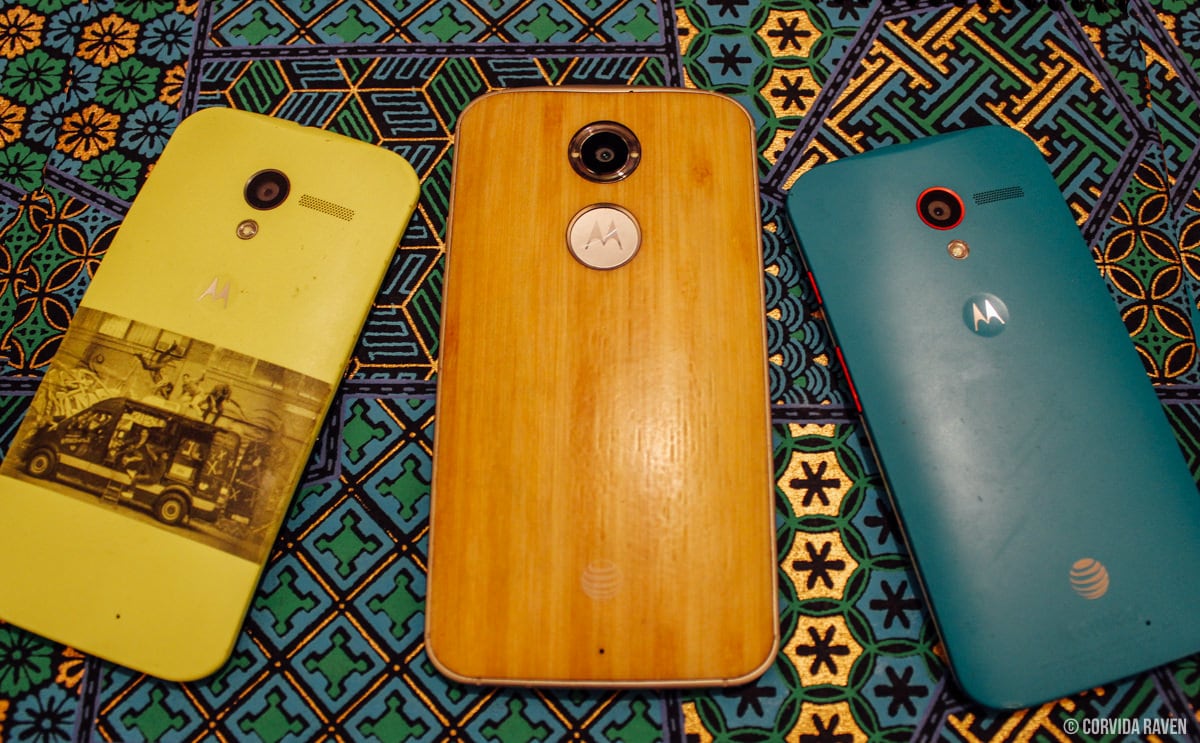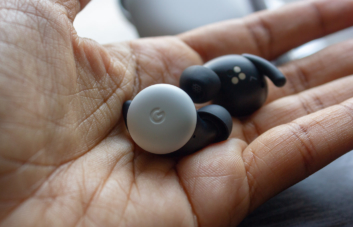Less is more when it comes to the Moto X, which is exactly why it’s one of the most attractive smartphone lineups on the market. Here’s a look back at what made the first and second generation Moto X so refreshing and how they made loyal users of many, including me.
Seamless Design
Since its debut, the Moto X has bucked flagship phone trends: from its modest screen size and customization options, to its curvaceous style in a sea of flat assed phones. It refuses to be a flashy flagship phone on steroids and stands out as a refreshing departure from the glitz and glamour of today’s high-end tech. The icing on the cake is that your Moto X doesn’t have to look like the next X thanks to MotoMaker’s customization options including premium wood back designs — warning: wood backs tend to rise over time.
Holding the Moto X (OG X) is like holding something that was made for your hand! From its nicely curved back to its sleek, all-plastic frame and modest 4.7-inch, 720p SUPER AMOLED display, the OG X feels better than it looks.
The 2nd gen Moto X (X2) loses some of this feeling to accommodate a bigger 5.2-inch, 1080p Super AMOLED display, but gains a premium look thanks to the aluminum band along its sides that doubles as an antenna. These are minor tweaks, but the X2 feels more seamless and put together than its predecessor, especially if you prefer the white-front color option.
Intuitive Experience
I wonder how many people have ever experienced Android as it was originally designed, without Samsung TouchWiz or HTC Sense skins. It’s not as overwhelming as these skins might lead you to believe. In fact, Android can be as clean, simple and subtle as iOS, while bringing better capabilities.
The Moto X bucks the “skin” trend, and gimmicky features, to present a near perfect replica of stock Android. It offers a little bit of something for everyone and Motorola is pretty quick at getting the latest OS updates to devices. More importantly, the lack of skins and gimmicky features, is a refreshing experience. Casual and power users alike might find the X’s select feature-set and stock android experience a refreshing departure from the bloated devices of today.
That’s not to say Motorola hasn’t added their own touches. In fact, it’s clear Motorola was intentional about what additional features they would add to their devices and user experience. The main features of the Moto X speed up performing common phone tasks while requiring less effort.

Under Google’s leadership, Motorola designed a different way of peeking at notifications that continues to outshine competitors. Moto Display flashes a glimpse of your notifications from the lock-screen without requiring you to turn on the display. Coupled with the AMOLED display that only lights up necessary parts of the screen, it saves battery by pausing when you’re not paying attention and saves you a button press by resuming when you pick up the X again. It quickly becomes a convenient norm when using a Moto X.

Before “Hey Cortana and Siri”, the OG X debuted the “OK Google Now” command that worked without touching the phone. Touchless Controls is now Moto Voice, supports custom phrases and contextual commands like “take a selfie”. This particular command opens your camera, starts a countdown with the front-facing camera and snaps a pic. Activating Moto Voice is a hit or miss sometimes, but when it works it can reduce time and energy spent on sending quick texts, initiating calls, looking for your phone or checking the weather before getting out of bed – and all without touching the phone.
Moto Action adds useful gestures like twisting the phone twice to open the camera and waving over the display to silence calls and alarms. There’s also Moto Connect, an alternative to Airdroid, to remotely control the Moto X from your PC. It’s the only feature I don’t use because it requires Chrome, which I don’t use, and I have no desire to control my phone from my browser.
Frustrating Call Quality
This blissful experience with the Moto X comes to a screeching halt when making calls. The Moto Xs’ microphones are in desperate need of a redesign. Friends frequently tell me they can’t hear me or that I’m breaking up when talking to them. I try re-positioning the phone closer to my mouth until I can almost eat it, but that doesn’t help. After a while I switch phones or go radio silent. On the flip side, people sound loud and clear to me, and AT&T provides great reception across both devices, though occasionally the X2 picks up a stronger signal.
Decent Camera
If call quality isn’t an deal breaker, the Moto Xs camera might be. The camera app has your basic photography settings (no gimmicks), but image quality just isn’t on par with the competition. It can produce Instagram worthy images, but the results will differ drastically based on lighting (the brighter, the better). The X2’s 12MP camera is an improvement over the OG X’s 10MP camera and there’s hope for the 21MP Moto X Play/Style’s camera. There’s not much to say about the front-facing camera. I don’t use it because I think they’re made for people still living in the 90s.
Still, there’s no denying the Moto X’s cameras have some catching up to do .
Fast Performance
Despite the so-so mic quality and camera, the Moto X performs with speed and grace. Both the OG X and X2 are fast and responsive when tapping, rotating and interacting thanks to 2GB of memory. Games run without hiccups across both devices, though the X2 can sometimes feel smoother and quicker. Overall, performance is the least of the Moto X’s worries.
Limiting Storage

How does the replacement of physical expandable storage with the cloud options impact user experience? Limited storage space tends to turns folks into micro-managers of their devices if they can’t afford to expand the amount of space available. I carry a second device just to have all of my music with me.
Some might say just buy the 32GB version for $50 extra. That’s a nice deal, but a 64GB micro-SD card costs less. Make $en$e? Keep in mind, what you pay for in storage isn’t exactly what you get. If you have a 16GB phone, you probably only have anywhere from 9-13GBs available to use. With the Moto X and X2 it’s around 9-10GBs. That’s less than my iPhone 5 (12.5GB free space).
Android Central has the 64GB Moto X Pure Edition with only 47GB of usable space. That doesn’t make $sen$e. This doesn’t matter as much with the new Moto Play and Style because they, thankfully, include micro-SD slots.
Efficient Battery
Moto Xs are designed to be efficient in power consumption, but with heavy usage they tire quickly. I mainly blame this on the sensors and displays. The Moto X 2014 can take an 8-hour call with the screen off while connected to wifi. With the screen on and sensors actively working to determine when my face is near the screen, I get closer to 4-5 hours of talk time.
I get a solid 6-8 hours of heavy usage out of the Moto X2 (3-4 hours SOT, low brightness, wifi, data, push notifications, and lots of app switching). This increases to 10-12 hours with moderate usage and 15-hours max with light usage. All-day battery life? Not for power users.
Qualcomm’s Quick Charge technology is a saving grace for the X2’s battery woes. The OG X has Quick Charge 1.0, which gives a negligible boost to charging low batteries. With Quick Charge 2.0, charging times are 75% faster. In my usage, the Moto X2 gains 40-50% battery life in 30-45 minutes when using quick charg at 10% battery life or lower. AndroidPolice gives a solid break down of the mechanics of quick, rapid, turbo and fast charging over here. You’ll need to buy a turbo charger to take advantage of this feature, though it would’ve been nice of Motorola to include one the way they do for the Nexus 6.
Buy it or Nah?
If you’re into the spec race or the hype, this might not be the phone for you. The Moto X lineup is designed to challenge the relevance of specs, features, and the hype they lend to devices. In doing so, the Moto X is worth almost every penny of their design, simplicity and features. Less really is more with a Moto X – more enjoyable. I recommend investing in a turbo charger to alleviate the battery shortcomings if you’re a power user, and capturing photos in the daytime to get the best image quality out of the Moto X cameras.
And you can’t beat the prices on these devices. The Moto X (2nd Gen) is $300-$350 /16GB – and no contracts necessary. If you’re into contracts and with AT&T you can get this phone for $100. You’ll have to go through a third-party to get the original Moto X, which can cost up to $350.







